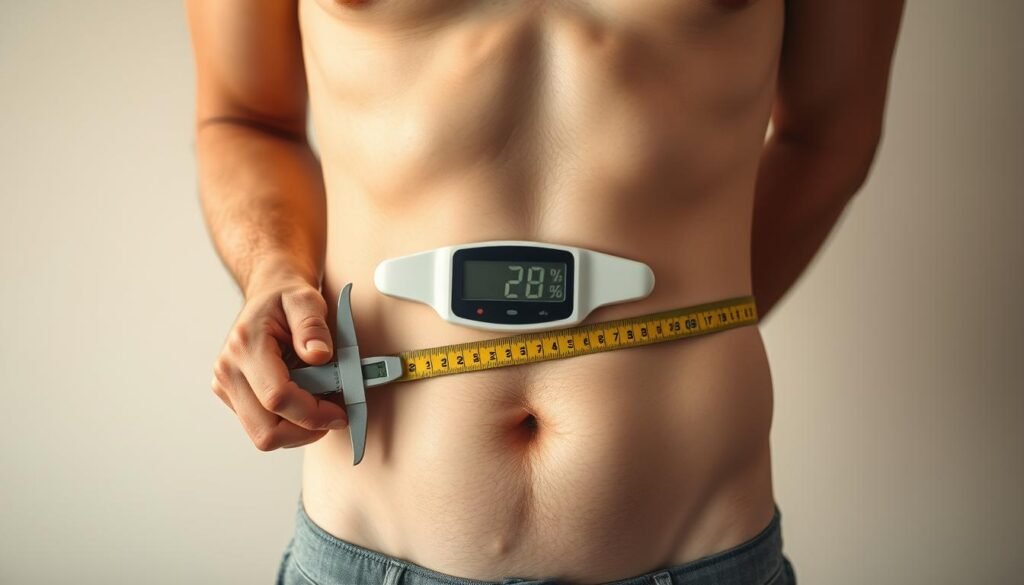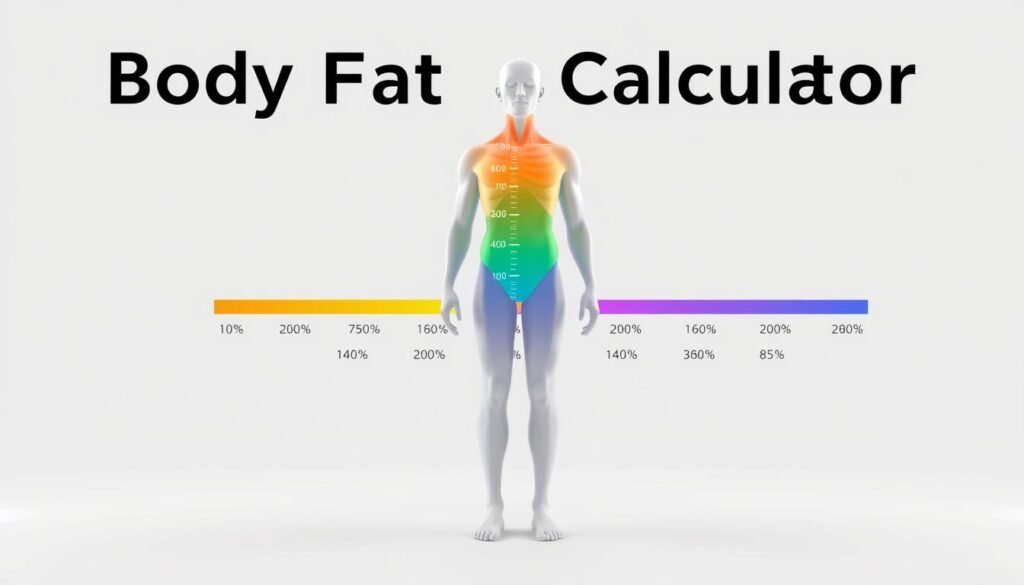Body Fat Calculator
Understanding your body fat percentage is crucial for assessing overall health and fitness. Our Body Fat Calculator provides a reliable estimate using scientifically validated methods, including the U.S. Navy and BMI approaches.
This tool requires simple measurements that can be taken at home, making it accessible for people wanting to track their fitness progress. By using our calculator, you can estimate your total body fat based on specific measurements and get an accurate indication of your health.
We’ll guide you through interpreting your results and what they mean for your overall health and fitness journey.
Key Takeaways
- Estimate your total body fat percentage using our calculator.
- Understand the importance of body fat percentage for your overall health.
- Get personalized insights based on your measurements and age.
- Track your fitness progress without expensive equipment.
- Set realistic fitness goals based on your body fat percentage.
- Monitor changes in your body composition over time.
Understanding Body Fat and Its Importance
Body fat, or adipose tissue, is a vital component of the human body, serving multiple purposes beyond energy storage. It plays a crucial role in maintaining our overall health and bodily functions.
What Is Body Fat?
Body fat, scientifically known as adipose tissue, is essential for storing lipids, which the body uses to create energy. It also secretes important hormones and provides cushioning and insulation. Understanding body fat is crucial for maintaining a healthy lifestyle.
The distribution of body fat varies among individuals, and its measurement is a more accurate health indicator than BMI because it distinguishes between fat mass and lean body mass.
Essential vs. Storage Body Fat
There are two types of body fat: essential body fat and storage body fat. Essential body fat is necessary for maintaining life and reproductive functions, differing significantly between men (2-5%) and women (10-13%). Storage body fat, on the other hand, is excess fat that accumulates in adipose tissue. Maintaining a balance between these two types is crucial for overall health.
Understanding the difference between essential and storage body fat helps in assessing health risks associated with excess fat, particularly visceral fat around organs, and in adopting a suitable diet and exercise regimen.
Body Fat Calculator

Get a clear picture of your health and fitness level with our body fat calculator. This tool is designed to provide you with an accurate estimation of your body fat percentage, helping you set realistic fitness goals.
How Our Calculator Works
Our body fat calculator employs multiple scientifically validated methods, including the U.S. Navy method and BMI estimation, to calculate your body fat percentage. To get started, you’ll need to take a few simple body measurements. We’ll guide you through this process to ensure accuracy.
The calculator then processes these measurements using specialized formulas developed through extensive research. This allows us to estimate your body fat levels accurately and provide a comprehensive overview of your body composition.
Interpreting Your Results
Understanding your body fat percentage is crucial for your overall health and fitness. Our calculator not only provides your current body fat percentage but also compares it to healthy ranges for your age and gender. This comparison helps you identify whether you need to adjust your diet or exercise routine.
The results include detailed information about your fat mass and lean body mass, giving you a complete picture of your body composition. We also explain how different body fat percentage ranges correlate with various fitness levels, from essential fat to obese categories.
By using our body fat calculator, you can track changes in your body fat percentage over time, measure the effectiveness of your diet and exercise programs, and make informed decisions about your health and fitness goals.
Methods for Measuring Body Fat
Understanding body fat requires employing one or more of the various measurement techniques available. The choice of method depends on the desired level of accuracy, the equipment available, and the individual’s comfort level with the measurement process.
U.S. Navy Method
The U.S. Navy Method uses body circumference measurements to estimate body fat percentage. This method involves measuring the circumference of specific body parts, such as the neck, waist, and hips, using a tape measure. The measurements are then used in a formula developed by the Naval Health Research Center to calculate body fat percentage. This method is relatively simple and can be performed at home, providing a reasonable estimate of body fat within 3-4% of more advanced methods for most people.

BMI Method
The BMI Method is a simpler, albeit less accurate, way to estimate body fat percentage. It uses a formula that correlates Body Mass Index (BMI) with body fat percentage, taking into account age and gender. While not as precise as other methods, it provides a general indication of whether a person’s body fat is within a healthy range.
Skinfold Measurements
Skinfold measurements involve using calipers to measure the thickness of subcutaneous fat at specific body sites. Techniques like the Jackson-Pollock and Durnin-Womersley protocols use different combinations of measurement sites to estimate total body fat percentage. When performed correctly, skinfold measurements can provide accurate estimates of body fat.
Each of these methods has its strengths and limitations, and the choice of method should be based on the individual’s needs and the desired level of accuracy.
Healthy Body Fat Percentage Ranges
Understanding healthy body fat percentage ranges is crucial for setting realistic fitness goals. Body fat percentage is a more nuanced measure of health than weight alone, as it distinguishes between lean mass and fat mass. Generally, a good body fat percentage range for women is 21 to 35 percent, and for men, it’s 8 to 24 percent, depending on age.
Ranges for Men
For men, healthy body fat percentages typically range from 8-24%. Athletes often have body fat percentages in the 6-13% range, while fitness enthusiasts usually fall within 14-17%. Acceptable ranges are considered to be 18-24%, and obesity starts at 25% and above. As men age, their body composition changes, with fat mass increasing and muscle mass decreasing, which affects their healthy body fat range.
| Category | Body Fat Percentage Range for Men |
|---|---|
| Athletes | 6-13% |
| Fitness Enthusiasts | 14-17% |
| Acceptable Range | 18-24% |
| Obesity | 25% and above |
Ranges for Women
Women’s healthy body fat percentages are higher than men’s, ranging from 21-35%. Female athletes typically have body fat percentages between 14-20%, while those at a fitness level usually range from 21-24%. The acceptable range for women is considered to be 25-31%, and obesity starts at 32% and above. Like men, women’s body composition changes with age, affecting their healthy body fat range.
| Category | Body Fat Percentage Range for Women |
|---|---|
| Athletes | 14-20% |
| Fitness Level | 21-24% |
| Acceptable Range | 25-31% |
| Obesity | 32% and above |
Health Implications of Body Fat Levels
Understanding the health implications of body fat levels is crucial for maintaining overall well-being. Maintaining appropriate body fat levels is essential for overall health, as both excess and insufficient body fat can lead to serious health complications that affect quality and length of life.
Risks of Excess Body Fat
Excess body fat, particularly visceral fat surrounding internal organs, is strongly linked to increased risk of cardiovascular disease, type 2 diabetes, certain cancers, and metabolic syndrome. The distribution of body fat matters significantly, with abdominal fat posing greater health risks than fat stored in other areas. Obesity, defined as having a body fat percentage above certain thresholds or a BMI over 30, is associated with decreased life expectancy and increased healthcare costs.

| Health Risk | Associated Condition | Body Fat Distribution |
|---|---|---|
| Cardiovascular Disease | High Blood Pressure, Heart Disease | Visceral Fat |
| Type 2 Diabetes | Insulin Resistance | Abdominal Fat |
| Certain Cancers | Breast, Colon Cancer | Excess Body Fat |
Risks of Insufficient Body Fat
On the other end of the spectrum, insufficient body fat can lead to serious health problems, including hormonal imbalances, reproductive issues, weakened immune function, and nutritional deficiencies. For women, body fat percentages below 15-18% can disrupt menstrual cycles and fertility, while men may experience hormonal issues when body fat drops below 5-8%. Athletes and those engaged in regular training need to be mindful of maintaining adequate body fat levels to support performance, recovery, and overall health.
Conclusion
With the Body Fat Calculator, you can gain valuable insights into your body composition. Our calculator provides a comprehensive analysis based on established guidelines from reputable health organizations, including the American Council on Exercise and the World Health Organization.
By understanding your body fat percentage, you can set realistic fitness goals and monitor your progress more effectively. It’s essential to consider factors like age, gender, and overall health when interpreting your results.
We encourage you to use our calculator as part of a holistic approach to health, incorporating balanced nutrition, regular physical activity, and stress management. For personalized advice, consult with healthcare professionals to ensure you’re on the right track towards a healthier lifestyle.
FAQ
How do I measure my body fat percentage accurately?
We can use several methods to measure body fat percentage, including the U.S. Navy method, BMI, and skinfold measurements. Each method has its own level of accuracy and convenience.
What is a healthy body fat percentage for men and women?
According to the American Council on Exercise, healthy body fat percentage ranges vary by age and sex. For adults, the ranges are generally considered to be 2-4% for essential fat, with total body fat percentages ranging from 6-13% for men and 16-23% for women.
Why is body mass index (BMI) not always an accurate measure of health?
We use BMI as a general indicator of health, but it has its limitations. BMI does not differentiate between lean mass and body fat, so athletes or individuals with a high muscle mass may have a high BMI without being overweight.
How often should I measure my body fat percentage?
We recommend measuring body fat percentage regularly, such as every 4-6 weeks, to track changes in our body composition over time. This can help us monitor the effectiveness of our diet and training programs.
Can I use a body fat calculator to determine my ideal body weight?
Yes, we can use a body fat calculator to estimate our ideal body weight based on our height, age, and body fat percentage. However, ideal body weight is also influenced by other factors, such as muscle mass and overall health.
What are the health risks associated with excess body fat?
Excess body fat is linked to an increased risk of various health problems, including obesity, diabetes, cardiovascular disease, and certain types of cancer. Maintaining a healthy body fat percentage can help mitigate these risks.

